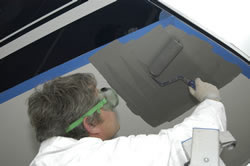Which type is best for me?
The severity of fouling can vary dramatically depending upon the temperature, water salinity, water flow, time of year and amount of sunlight.
Most anti-foul coatings are designed to cope with a wide spectrum of fouling and generally speaking there are three main types of antifouling, for a range of hull types and mooring conditions:-
Self Polishing (eroding) – the popular choice
As the term suggests, think of a bar of soap and this helps to describe the relative soft nature of these products and how they work.
Through the flow of water across the hull a fresh layer of biocide is continually exposed on the outside to repel any fouling. Provided that sufficient coats are applied from the outset, multi-season performance can be expected, saving you time and money.
Once applied an annual check and jet-wash on the hull, to revive the coating, is normally all that is needed. Most users find that the overall performance of self polishing antifouling is very hard to beat.
Understandably boats with drying moorings are not really suited to these products.
Hard types
These products have a general appeal and will work just as well in a range of conditions including salt and fresh water. Due to the leaching nature of the biocide, these products do not erode as such and can be used for drying moorings.
Hard types are resistant to abrasion and often favoured by racers who can burnish the hull with wet & dry prior to launching.
Hard types can be effective up to very high boat speeds of up to 70 knots and often favoured by powerful motorboat owners. These products are best
re-applied on an annual basis.
Non biocidal, foul release types
These work due to the slippery nature of the surface, which fouling finds difficult to adhere to. As a result they are not normally suitable for drying moorings.
The other major benefit, is less water resistance on the hull, meaning better fuel economy and more responsive handling through the helm.









